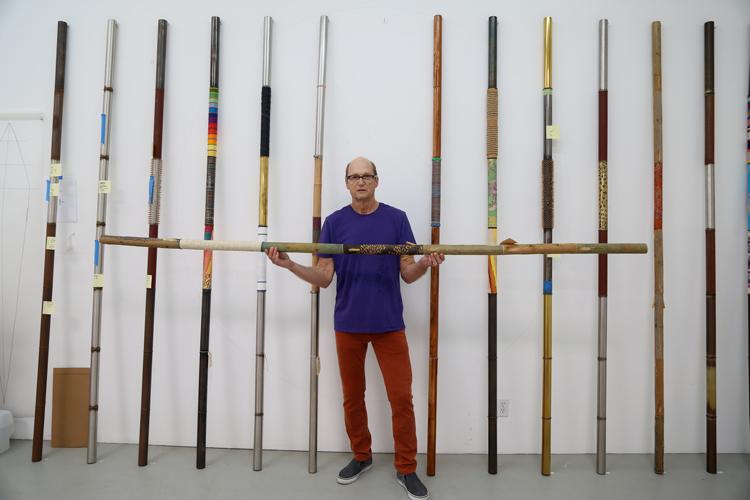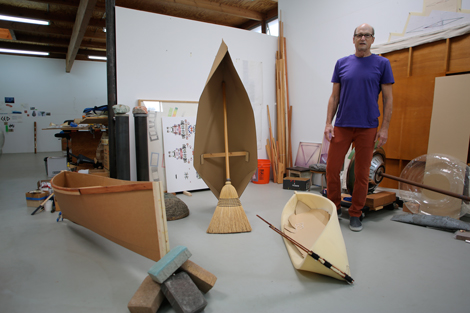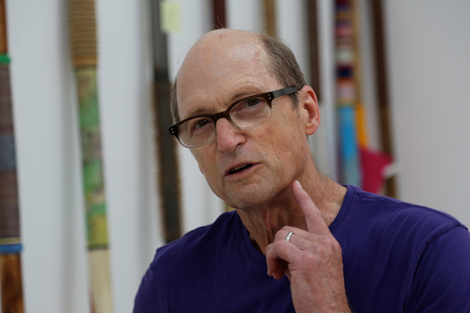Just blocks from Venice Beach near Appleton Way I’m wandering down an alley, trying to find Jud Fine’s studio. Over the cell he tells me to look for the DWP truck parked in front. But as I turn the corner the truck is pulling away. I’m not quite sure which nondescript gate or back alley garage I’m looking for.
I enter what I believe to be Fine’s studio, practically tripping over a flimsy half-foot panel strip at the bottom of the doorway. He tells me it’s there in order to block Bougainvillea blossoms that blow into the studio. It was then that I knew I was dealing with a genius, or at least a nutty professor.
He greets me in a workshop filled with bandsaws, table saws, tools and dormant machinery draped in canvas. Fine and his wife/art collaborator Barbara McCarren share the workshop but also have separate studios on the backlot of a residence they once owned (apparently they worked out some kind of deal as their studios were already there). Their art collaboration is referred to as McCarren/Fine. They do large-scale public projects together, as well as fine art projects.
An artist whose work is shown internationally and held in many prestigious collections, Fine is also a professor of art at the Roski School of Fine Art and Design at USC and has taught there for 35 years. He was one of the core faculty when I attended grad school 1986–88. I didn’t work directly with him, but he taught graduate seminar the first semester I was there and hung out with the grad students at parties and events.
A bespectacled 70-year-old—though preserving a physique of someone in his 40s, svelte like a surfer (a passion he had in his teens)— he leads me upstairs to his spacious studio as he bops around in rust-colored jeans with a blue-gray T-shirt and Vans tennis shoes, showing me recent McCarren/Fine projects, one in particular that just arrived from China. His studio is crammed with seemingly finished projects, maquettes, and many works in progress. And there the “poles” are. All lined up against the wall. Fine’s one consistent artwork is his poles. The poles are his babies, his spears, his weapons, his markers. They are sculptures that he continues to make ever since the first one appeared in 1972 at Documenta 5.
Philosophy & Pedagogy
Fine enjoyed a prosperous art career throughout the ’70s and decided it was time to move to New York. He was all ready to go when he was unexpectedly offered a position at the USC sculpture department in 1980. So determined was the dean to get Fine on the faculty that he made an offer that turned Fine’s head and changed his plans. He unpacked his bags and accepted the post; he’s been at USC ever since.
Fine was elevated to tenure track right away and was showing regularly. “But back then, no one wanted to teach the graduate students,” he says. “So I always got to teach them.” Fine thus became the director of the school’s Master of Fine Arts program. David Bunn joined the USC faculty soon after and became interested in the graduate program, wanting to heighten its profile. “After that, David and I alternated running the graduate program. A few artists came in like Ken Price,” he says, but basically it was Bunn and Fine for years. Then-Dean Ruth Weisberg was an advocate of Fine and Bunn’s efforts, and with her blessing and support, the MFA program gained some notoriety, with faculty additions such as Charlie White, Joshua Decter, Frances Stark, Gary Simmons, Andrea Zittel and Sharon Lockhart.
Fine is an ideal mentor for graduate students, especially in today’s art world where artist’s statements have become almost as important as the artwork itself. Fine appears to give teaching equal priority to his art-making. He’s a deep thinker and articulates a personal credo that he believes sums up the unique mission of the artist: “Hypothecate a premise without having to prove it.”
Where math and science rest on proofs, art must stand on conviction, the artist’s commitment to his or her particular vision. For Fine, it came as a revelation, and helped drive his original choice to become an artist. “It wasn’t an emotional decision —it might have been—but I was covering it over with this very clear rationale for being an artist. My project then in graduate school was to determine what an artist was. So when I fell into teaching, the question and the process was just a given.
“This is the subject. Why are you an artist? What are you making art for? Why are you here? What is art? These are essential questions, coupled with the idea that anybody could be an artist.” Fine pauses, adding incidentally, “Because I’m an artist. So, therefore, anybody could be an artist.”
Fine regards the idea of an artist following an innate calling as an absurdity, although he’s quick to add that his wife knew she wanted to be an artist as a child. “I’m not denigrating that notion,” he tells me in an unconvincing manner. “I could go further and say that teaching of art, the field of art, is the study of creativity. The idea of it is not about looking for people that are inherently good [at making art], it’s looking for people that want to do it. That have the desire,” he says, in practically one breath. “And you can be as critical and tough as necessary because, what the hell, that’s what the world is about, and it’s a personal decision. And if you want to be an artist, then you ought to be able to answer the questions that are generated.”
Surfin’ USA and Vietnam
Fine grew up in Manhattan Beach, a surf town about 20 miles southwest of LA. He had no aspirations to being an artist, and zero exposure to fine art other than a few coffee-table books. A career in making art never even entered his mind. After high school he thought he might want to be a pro surfer and one day caught one of the last propeller-plane flights to Hawaii, a rough ride with only waves and whitecaps below. But after catching his first double overhead wave, he admitted it was more fearsome than fun. The thrill was gone.
Fine came back home, enrolled in community college and majored in math. He “flunked slide rule, but aced history,” so he changed his major to history, completing his undergrad at University of California, Santa Barbara.
“Vietnam was still raging, so it was essential to go to graduate school,” Fine says. He stayed on at Santa Barbara and pursued a PhD in American Intellectual History, but something was amiss. He made an F on one of his essays and talked the professor into letting him rewrite his paper, then made an A+. Not only did that not satisfy him, but it prompted him to change his entire collegiate course.
“I needed to switch to a different academic field, one that would allow me to hypothecate a premise without having to prove it. Allowing the force of conviction of its delivery to be its proof,” he says—with so much conviction that I’m buying it. This was his epiphany, the insight that set the course of the rest his life. “I figured there’s three academic fields for which that’s possible: philosophy, literature and art.” He chose art, he says, because he was tired of “library grease,” referring to the many hours spent in the library as a student of history.
Long story short, after taking some art courses at UCSB in order to put together a portfolio, Fine got accepted to Cornell in 1968 for his sculpture, a feat he describes as incredible luck—there were over 200 applicants. “At the time, everyone was trying to stay in school, a lot of older artists were going back to school because the art market had dried up. They could maybe get a TAship, hibernate for a couple of years, be in school and avoid Vietnam,” Fine says.
He realized just how lucky he had been when he had his first studio visit after starting at Cornell. The faculty advisors remarked on the fact he wasn’t working from the ceiling anymore. Fine was dumbfounded, but stayed cool. Afterwards he realized what the professors were referring to. He had mislabeled the slides he had sent to be considered for the MFA program; specifically, top and bottom were reversed, meaning the images were viewed upside-down. Fine had photographed the sculptures on a wooden pedestal and in close-up the sculptures appeared to be hanging from the ceiling. His work had been judged on the opposite terms of what he had intended!
Even though Lady Luck seemed to be with him, things weren’t working out. Fine’s work “sucked,” he says now, and he felt lost: “The work was shit. I was just making bigger versions of what I made back there [at UCSB]. I walked across campus and the sun beat down on the snow and I said, ‘Just fuck it,’ and got on a plane and went back to Santa Barbara. So I just took acid and hung out there on the beach for a couple of months.”
Turns out, “Luck was on my side,” Fine says (indeed, again). At the exact time he decided to tune in and drop out, Cornell had just switched to a quarter system and wouldn’t be adjourning until February. By that time Fine had had enough LSD and sunshine and realized he had made a mistake. He went back to Ithaca, ready to get down on his knees, but because of the extended break, the administrators at Cornell were unaware that he had even left. Fine recalls this story fondly, with a truant teenager’s glee at not getting caught.
Besides dropping acid, Fine was also reading a lot of books at the time; John Barth being a favorite. And during his soul-searching grad-school sabbatical, he conceived of a second fundamental question: “What is art?” (Of course I imagine him tripping on the beach when this revelation came about.)
Here again, Fine changed his way of thinking. He decided that it was more important to know first what the work is supposed to do, then make the art—not the other way around. “Not what it’s supposed to look like necessarily, but what it’s supposed to do, what its function will be,” Fine insists. “It’s the idea that’s driving the work. If I don’t like it, I can change the idea. But I can’t change its consequences.” Fine exhales, “It just freed me.”
Fine’s experience was typical for a graduate student, he now knows, and it has informed his approach to teaching ever since. “Everything broke down, I went through this major crisis; the work was completely different, on a completely different track. I could defend it. It had a longer trajectory, and it was totally thought out.”
Fine is beginning to define art, whether he likes it or not.
Documenta
After grad school in 1970, Fine returned to the West Coast and started teaching ceramics at Harbor College. He was teaching two days a week and making art the rest of the time. He started showing with Ronald Feldman Gallery in New York and Riko Mizuno in Los Angeles.
Fine has been with Ronald Feldman ever since. I marvel on the longevity of that relationship and ask him if that was where he first exhibited his work. “Well, no, it wasn’t my first show,” he corrects me, adding rather sheepishly, “The first show was at Documenta.” “Really! Your very first exhibition?” I exclaim. Fine grins and even chuckles a little. It turns out this story hinges on still another remarkable stroke of fortune.
Fine was working for Los Angeles artist Ron Cooper at the time when Documenta curators visited Cooper’s studio, searching for artists for 1972’s Documenta 5. Fine happened to be on hand, and the curators asked if they might see Fine’s work as well. Fine ended up in the show, which was an immense stroke of luck, as Documenta 5 is now considered one of the more famous Documentas, assembled by the renowned Swiss curator Harald Szeemann; a total boon for Fine’s subsequent art stature.
His career seems to be marked by happenstance, but now in his teaching Fine presses his students to be deliberate, articulate and intentional. There isn’t any correct answer, necessarily, but he wants his students to know where they’re going before they get there. “To what degree can the artist control his audience?” Fine asks. “What is the nature of this thing I’ve stepped into? What is the field?” Fine says this with a passion seemingly equivalent to the very first time he contemplated the question.
The Troubles
I ask Fine if he believes USC to be one of the top art schools in the nation. “It was on the road to that,” he answers quickly. “The MFA program was probably the most talked-about MFA program in the country. I can definitely say if one wanted to go to a research university, there were only four schools to pick from: Columbia, Yale, UCLA and USC.
“SC wasn’t in that group 10 years ago. But SC muscled in because of the nature of its program, the success of its graduates, its funding.” He adds, “And its core faculty. A graduate program is only as good as its primary teaching faculty. What’s the first thing any prospective student does? They look at the faculty. So that’s how we did it. That’s how it was done. And I say it’s the most talked-about because we’re the most recent player. Yale is talked-about, but you don’t need to talk about Yale anymore. It just is. So students are asking, ‘What about SC?’ So SC was the most talked about program. Now that’s not reflected in the U.S. News and World Report rankings, but that’s the reality on the ground and that’s something our dean doesn’t know because she doesn’t know the art world and she doesn’t know art. USC’s program was successful. We successfully placed ourselves in a cohort with the best MFA programs. Now why would you throw that away? It makes no sense.”
Fine is referring to the recent fiasco of the MFA program at USC—the walkout of first-year students and the wholesale withdrawal of the incoming class. At this time, there is just one student enrolled in the MFA program. Fine and I had agreed we wouldn’t necessarily discuss it, but it was the elephant in the studio, and it had to come up.
The dispute is especially disappointing to Fine since he could almost call the USC MFA program his baby. He’s a reasonable guy, though. “Maybe it needs to be adjusted, maybe it’s too expensive. Maybe one needs to get more out of the faculty in relation to other parts of the undergraduate program. There’s lots of things you can do, but the way to do it is to go to the core faculty and say, ‘Look, I need to change it this way, help me, what do you think? How can I accomplish these goals?’ That’s what leaders do. They work with people around them. Well that isn’t what our leader did. She eliminated the core faculty and, in all but name, terminated the MFA program.”
With the Fall semester looming, the future for the MFA program does look bleak. But the big questions are still out there: “What is art?” “What is the nature of this thing I’ve stepped into?” And even if there’s only one student, that new practitioner can contemplate just as Fine did back in the ’70s. The beach is still just around the corner, and LSD, and John Barth. And at USC, there’s still Jud Fine. I’d say that one student just got lucky.



